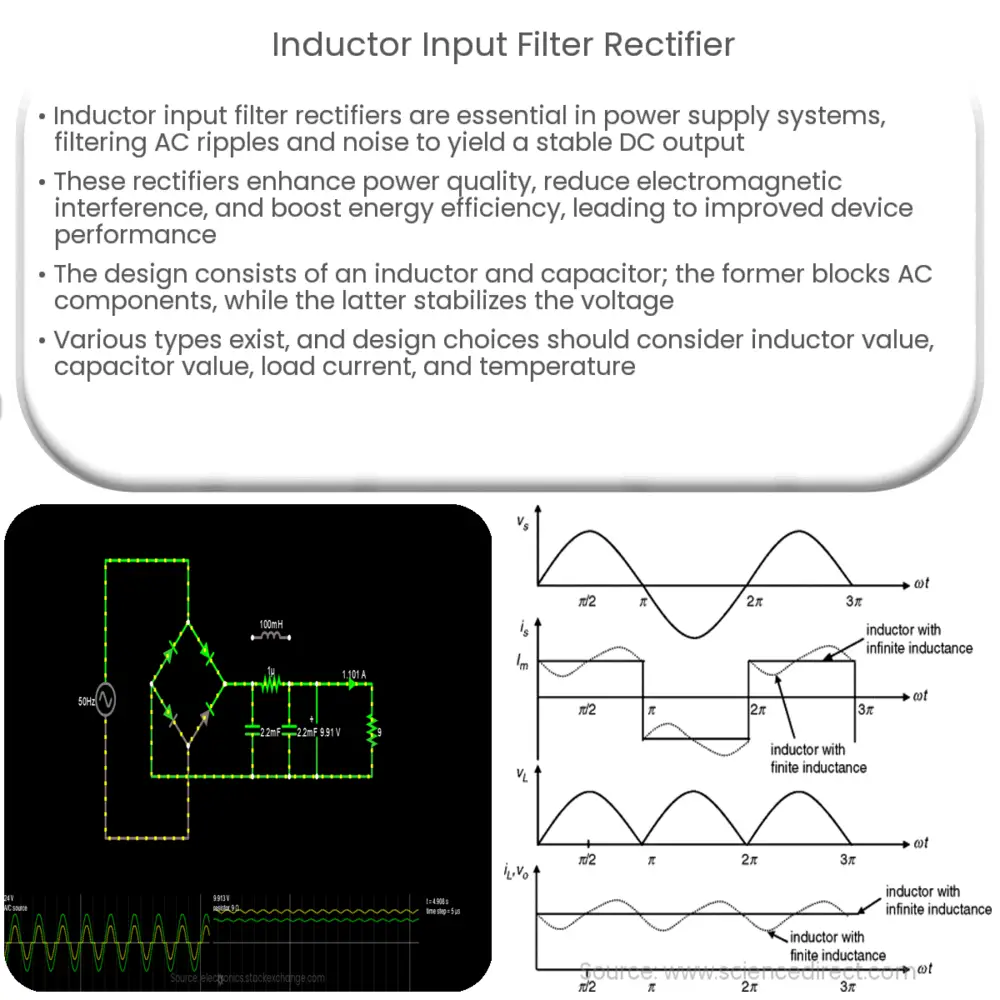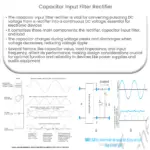An inductor input filter rectifier stabilizes DC voltage by filtering AC ripples & noise, enhancing device performance and reducing EMI.

Inductor Input Filter Rectifier: An Overview
Introduction
An inductor input filter rectifier is a crucial component in power supply systems and plays a vital role in providing a stable and efficient DC output voltage. The primary purpose of an inductor input filter rectifier is to filter out any AC voltage ripples and noise present in the output of a rectifier circuit, converting it into a smooth DC waveform. This article discusses the importance, working principle, and benefits of using an inductor input filter rectifier.
Importance of Inductor Input Filter Rectifiers
Power supply systems are a key aspect of modern electrical and electronic devices. They ensure that devices receive a steady and controlled DC voltage that meets the operational requirements. The conversion of AC to DC is typically achieved using a rectifier circuit. However, the output of a rectifier circuit usually contains AC ripples and noise, which can negatively impact the performance of electronic devices. Inductor input filter rectifiers are employed to remove these unwanted components, resulting in a clean and stable DC output voltage.
Working Principle
An inductor input filter rectifier consists of an inductor (L) and a capacitor (C) connected in series with the output of a rectifier circuit. The inductor acts as a low-pass filter, allowing DC current to pass through while impeding the flow of AC ripples and noise. The capacitor, on the other hand, works as an energy storage device that smoothens the waveform and maintains a steady voltage across the load.
When AC voltage is applied to the input of the rectifier circuit, it is converted into a pulsating DC waveform. The inductor resists sudden changes in current due to its inductive reactance (XL), which increases with frequency. As a result, the inductor effectively blocks high-frequency AC components while permitting the low-frequency DC current to flow through. The capacitor further filters the waveform by charging and discharging as the voltage fluctuates, thus maintaining a near-constant voltage across the load.
Benefits of Inductor Input Filter Rectifiers
Using an inductor input filter rectifier offers several advantages in power supply systems:
- Improved Power Quality: By removing AC ripples and noise, inductor input filter rectifiers ensure a clean and stable DC output voltage, which enhances the performance and reliability of electronic devices.
- Reduced Electromagnetic Interference (EMI): Filtering out high-frequency components minimizes EMI, which can interfere with the operation of other nearby electronic devices and degrade signal integrity in communication systems.
- Increased Energy Efficiency: A smooth and stable DC voltage allows electronic devices to operate more efficiently, reducing power consumption and prolonging the life of components.
In summary, an inductor input filter rectifier is a critical component in power supply systems, ensuring the delivery of clean and stable DC voltage to electronic devices. Its ability to filter out AC ripples and noise, along with its other benefits, make it an essential element in modern electrical and electronic applications.
Types of Inductor Input Filter Rectifiers
There are various types of inductor input filter rectifiers, depending on the configuration of the rectifier circuit and the specific application requirements. Some common types include:
- Half-Wave Rectifier with Inductor Input Filter: This configuration uses a single diode for rectification and is suitable for low-power applications. However, it results in a higher ripple content, necessitating a larger filter to achieve a smooth DC output.
- Full-Wave Rectifier with Inductor Input Filter: This configuration uses two or four diodes to achieve full-wave rectification, resulting in lower ripple content and a smoother DC output. The inductor input filter in this setup can be smaller, making it more suitable for high-power applications.
- Bridge Rectifier with Inductor Input Filter: A bridge rectifier utilizes four diodes in a bridge configuration, allowing for full-wave rectification with a compact design. It is commonly used in high-power applications due to its efficiency and the relatively low ripple content in the output voltage.
Design Considerations
When designing an inductor input filter rectifier, several factors must be taken into account to ensure optimal performance:
- Inductor Value: The inductor value (L) should be chosen to provide adequate filtering at the desired frequency range. A larger inductor value results in better filtering but may increase the size and weight of the filter.
- Capacitor Value: The capacitor value (C) should be chosen to maintain a stable voltage across the load and to minimize voltage ripple. A larger capacitor value provides better smoothing but may lead to slower transient response and increased size.
- Load Current: The filter components should be designed to handle the maximum load current without excessive voltage drop or saturation of the inductor.
- Operating Temperature: Temperature variations can affect the performance of the inductor and capacitor, so it is essential to select components with appropriate temperature ratings for the intended application.
Conclusion
Inductor input filter rectifiers are vital components in power supply systems, responsible for filtering out AC ripples and noise to deliver a clean and stable DC output voltage. They play a crucial role in ensuring the efficient operation of electronic devices and reducing the impact of EMI. By understanding the working principle, benefits, types, and design considerations of inductor input filter rectifiers, engineers can design more reliable and efficient power supply systems for various applications.



